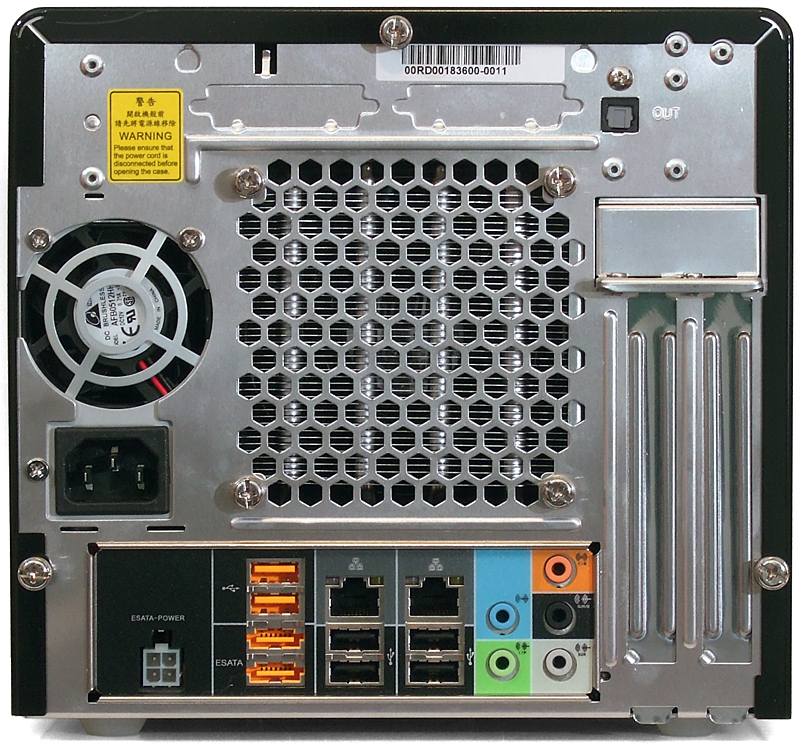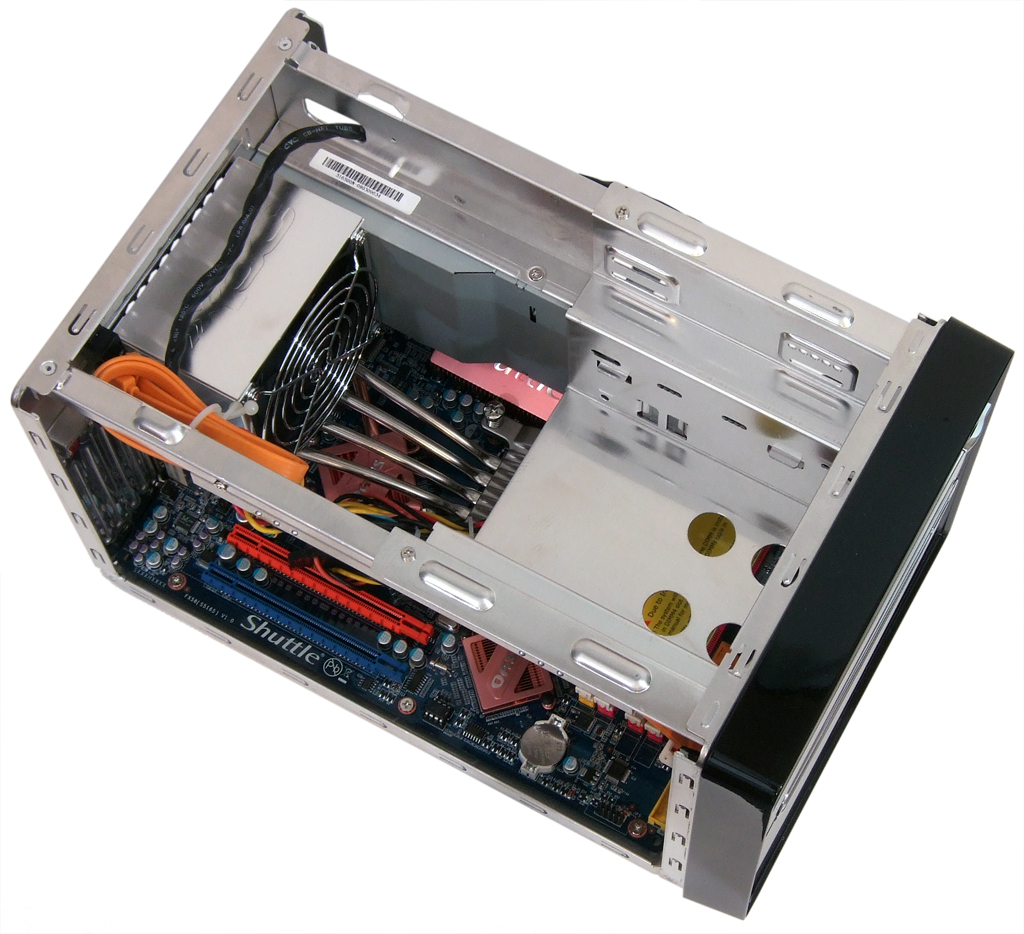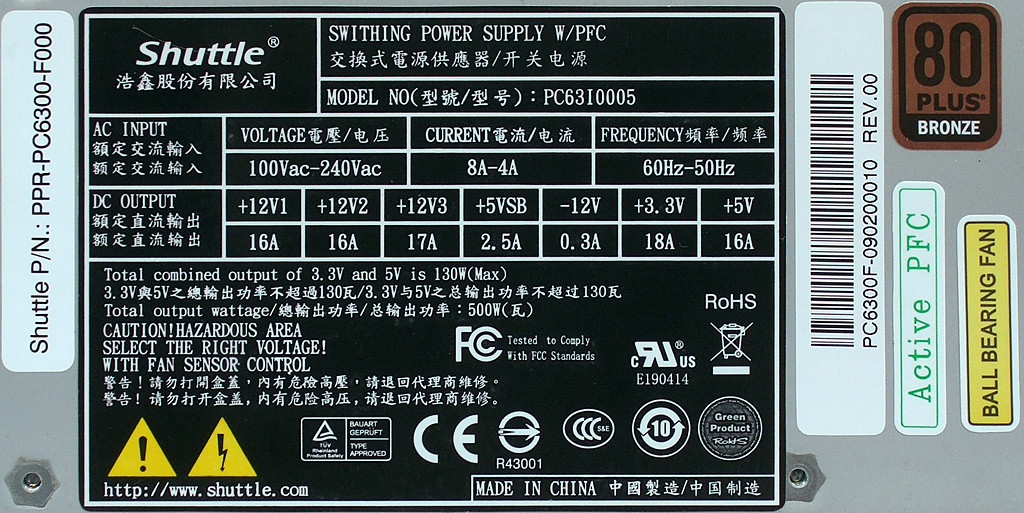Shuttle’s SX58H7 Ultra-Portable Core i7 Platform
Got Guts?
Shuttle Form Factor is a proprietary two-slot spin-off of an ATX design. Similar cube-shaped cases using larger motherboards are available as Micro-ATX and ATX cubes, but calling those components “SFF” is a misnomer, since hardware of any specific form factor must by definition be interchangeable.
Beneath a flip-down spring-loaded optical drive cover, two accessory doors open to reveal a 3.5” external bay, headset jacks, USB 2.0 ports, an eSATA port, and a reset button. The external bay also has additional holes for installing a second internal drive behind its cover.
A look around back reveals Shuttle Form Factor's reduced number of expansion slots compared to similarly-shaped Micro-ATX cubes. Its latest motherboard loses legacy ports but gains eSATA, and a proprietary adapter allows internal SATA devices to be powered externally through an included cable.
Perforated side panels and gaps around components allow air to move freely towards the center of the case, where it’s removed by an exhaust fan. A drive tray above this space holds a 5.25” (external) and two 3.5” devices (internal and internal/external).
Removing the drive tray allows easy access to four DDR3 memory slots, three of which are configured for triple-channel mode. Shuttle specifies that its motherboard supports DDR3 1066, 1333, and 1600, but the platform's current BIOS does not support the required 5x and 6x memory multipliers for speeds above DDR3-1066 at stock CPU base clock. Shuttle promises a BIOS update soon.
A heat-pipe assembly transfers heat from the CPU to the rear panel, where a 3,800 RPM, 92 mm fan cools its radiator. The 540 milliamp Protechnic model MGT9212UR-W25 fan is rated at 72.85 CFM and 41.3 decibels at full speed, but Shuttle’s smart fan controls keep it whisper-quiet most of the time.
Rated at 500 W maximum output, Shuttle’s latest power supply is also endowed with an 80 Plus Bronze certification. These specifications are most impressive in a unit slightly narrower than even the tiny TFX form factor, but the lack of any “combined 12 V” output rating is a bit of a letdown.
Get Tom's Hardware's best news and in-depth reviews, straight to your inbox.
-
one-shot It is interesting to see the total power consumption of the Shuttle system never went above 212W. This is with a Core i7 and a GTX 260. This system comes with a 500W PSU, which is more than enough. It is interesting to see that large PSUs are definitely not a necessity as the trend continues towards circuit breaking sizes. I have a 650W with 3x19A 12V rails and that is plenty for me. 212/500=42.4% of the PSUs total output. This is fine, but you could get by with an even smaller PSU.Reply -
Crashman one-shotIt is interesting to see the total power consumption of the Shuttle system never went above 212W. This is with a Core i7 and a GTX 260. This system comes with a 500W PSU, which is more than enough. It is interesting to see that large PSUs are definitely not a necessity as the trend continues towards circuit breaking sizes. I have a 650W with 3x19A 12V rails and that is plenty for me. 212/500=42.4% of the PSUs total output. This is fine, but you could get by with an even smaller PSU.Reply
It actually went to 425W peak with both Prime95 (8-threads) and Crysis GPU bench (2560 Very-High 8x) running at the same time, but that's not a very realistic test. -
xsamitt This is less an article more like an extended IMHO.Stay tuned Monday when it's back to SSD or and overclocking contest.Reply -
xsamitt This is less an article more like an extended AD IMHO.Stay tuned Monday when it's back to SSD or and overclocking contest.Reply
-
Crashman xsamittThis is less an article more like an extended AD IMHO.Stay tuned Monday when it's back to SSD or and overclocking contest.Reply
It shows how the system compares to a standard motherboard and cooler in performance and overclocking. If you want more than standard cooling, you can read any of the X58 motherboard shootouts where a big liquid cooler is used. -
pivalak I'm curious, how noisy is it when idle and at full load? Does the fan always run at full speed (i.e. 41.3 dB) when the GPU is used?Reply
Something I found with my current Shuttle box (i.e. SN21G5) is that, having added a modest dedicated graphics card (i.e. NVIDIA 9500 GT), the heat generated by the GPU was enough to keep the main fan spinning at low speeds even when idle. So as soon as the system is put under some load, even if the GPU is idle and only one CPU core is used 100%, the fan will spin at almost full speed generating quite some noise.
Since these small computers are often placed on the desktop, next to the user, the noise level is even more apparent than with other systems which generate similar decibel figures, but rest on the floor, etc. So... should I move away from SFF for my next PC if I want a silent Core i7 system with a GTX 260 GPU? -
FrozenGpu So what comes w/ this, I figure the Case, PSU, Motherbaord, CPU?, RAM?Reply
I can't really seem to figure this part out, at ava direct they have this XPC SX58H7 for about $688 I think, but again nothign conclusive as to what it comes w/.... -
thejerk FrozenGpuSo what comes w/ this, I figure the Case, PSU, Motherbaord, CPU?, RAM?I can't really seem to figure this part out, at ava direct they have this XPC SX58H7 for about $688 I think, but again nothign conclusive as to what it comes w/....Reply
http://www.newegg.com/Product/Product.aspx?Item=N82E16856101082
Case, mobo, PSU. Yes, it's expensive.






